Antique & Vintage Papers
PAPER.
Despite the onward unstoppable march of super technologies that we're all now experiencing (and enjoying), nothing has changed the world quite like paper has for so many people and for so many years.
Used in almost every form of communication from love letters, declarations of war and peace, trade treaties, money, bank statements, certificates, maps, instruction manuals, printed art, paintings, books. legal documents, shopping lists, product packaging, newspapers, receipts, shopping bags, labels, food storage; the list goes on and on.
Paper is available to almost every single person on the planet, it costs next to nothing. It's portable, durable, easily stored, it's biodegradable and incredibly to use.
The mass production of paper began in China and Japan and spread to southern Europe very early in the 11th century where it was all made by hand until the 19th century with the introduction of steam driven papermaking machines.
Where once it was a ubiquitous commodity, handmade paper is now the product of cottage industries dotted around the globe made by a handful of dedicated women and men committed to the upkeep of the craft. Up until the 1800s, handmade was the only way.
The antique 18th century papers we sell were produced just a few years before papermaking machines came into existence and are some final examples of handmade, everyday paper. The vintage 19th and 20th century papers we sell are pretty much the last of the very very high quality papers made using best quality fibres and made in largeish volumes, on a commercial scale. Manufacturers such as J Whatman, Hayle Mill represented the very best of handmade paper. Yes, there are a handful of mills still operating and producing superb papers but not on the scale that say, Whatman did.
What's so special about vintage and antique paper?
Firstly there's the rarity; good quality old paper is so hard to find.
Secondly, handmade papers for fine art were made by time served craftspeople and the quality was/is fabulous. Not just the way it was made but the materials and fibres that were used to make them.
Most of the fibres in the old papers were linen or cotton rag. That is to say they used recycled clothing to make the pulp. They cut them up and beat them for days to make the base fibre. These fibres were longer and stronger than the fibres we use today to make paper and so they performed in better, they made better paper.
Today's papers are usually made with wood pulp or something called cotton linters. Cotton linters are a by product of the cotton industry and they are neither as long or as strong as rag fibres, therefore the sheets made with these tend to be inferior.
Thirdy is the sizing. Sizing is an added ingredient that allows water based media (paint and ink) to sit on the surface of the paper. Without sizing, paints and inks seep into the paper and blot. The most effective form of sizing is gelatine which is an animal product. Nowadays most papermakers use a vegetable starch or a chemical called Aquapel. Aquapel is a product used to coat windscreens of vehicles to help drive away water. It works as a sizing agent but not as well as gelatine.
Here's a short 3 minute film showing you the process of making paper from recycled rag.
Our selection of paper ranges from the 1850s through to the 1980s. We specialise in papers from three mills:
J Whatman paper
J Green & Sons (including Hayle Mill & Barcham Green) -
WS Hodgkinson
Usage - most of these papers were marketed as Drawing Papers but were meant for multipurpose use from watercolour, printmaking, pen & ink etc. We have seen most of these papers used successfully in watercolour, letterpress, etching, screenprint, drawing, pastels and even digital print.
J GREEN & SONS
The Green family were engaged in paper making from the 17th century until 1987 and produced papers under various names including; J Green & Sons, Barcham Green, FJ Head and Hayle Mill.

Responsible for making many much loved papers of incredible quality, these are still highly sought after by artists, printmakers and bookbinders today.
J WHATMAN
Made variously from linen and cotton rag, these are gelatin sized and of the highest possible quality. The condition of the papers are good to excellent with some sheets showing some minor signs of age.
J Whatman paper was used by the artists Constable, Rossetti, Picasso, Henry Moore, Thomas Gainsborough and J M W Turner. William Blake used Whatman paper for four of his illuminated books. Audubon's Birds of America was painted on Double Elephant J Whatman paper. Wellington wrote many of his famous dispatches on J Whatman paper and Napoleon sat on the island of St Helena and wrote his long and detailed will on J Whatman paper only three weeks before his death in 1821. George Washington signed many state documents on J Whatman paper and Queen Victoria chose J Whatman paper for her personal correspondence. In the 1930's Soviet leaders used the paper to publish their five year plan for the future of the USSR while the Peace Treaty with Japan was signed on Whatman paper at the close of World War Two.
The listings detail the size in mm, inches and traditional paper size (eg Medium, Imperial, Double Elephant etc.) The weight is in gsm and has been calculated by measuring and weighing the sheets
WSH
Heritage papers made in the 1950s and 1960s by one of the most important English paper makers; W.S. Hodgkinson & Co., Ltd. at the Wookey Hole mill in Somerset.
These have been tried and tested with: watercolour, letterpress, screen printing, digital inkjet, drawing, pastel, pen & ink, marbling.

